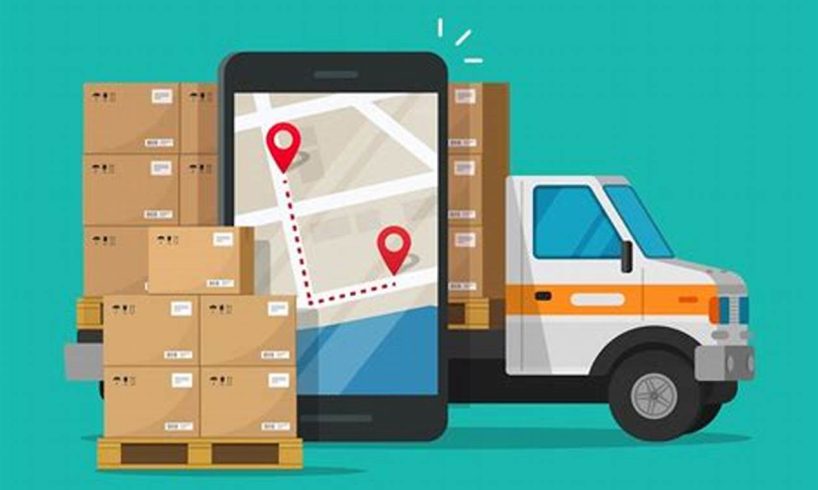
Logistics carrier tracking is the process of monitoring the movement of goods from one location to another. It involves tracking the shipment’s progress, estimated delivery time, and any potential delays or issues.
Logistics carrier tracking is essential for businesses that need to manage their supply chains effectively. It allows them to:
- Improve customer service: By providing customers with real-time updates on the status of their shipments, businesses can improve customer satisfaction and reduce the number of inquiries about shipment status.
- Reduce costs: By tracking shipments, businesses can identify inefficiencies in their supply chain and take steps to reduce costs.
- Increase efficiency: By automating the tracking process, businesses can save time and resources that can be allocated to other tasks.
Logistics carrier tracking has been around for many years, but it has become increasingly important in recent years due to the growth of e-commerce. As more and more consumers shop online, they expect to be able to track the status of their shipments in real time.
In this article, we will discuss the benefits of logistics carrier tracking in more detail and provide tips on how to implement a tracking system for your business.
1. Real-time visibility
Real-time visibility is a key aspect of logistics carrier tracking, providing businesses with the ability to monitor the movement of their shipments at any given time. This is achieved through the use of GPS tracking devices, RFID tags, and other technologies that allow businesses to track the location of their shipments in real time.
- Shipment tracking: Real-time visibility allows businesses to track the location of their shipments from origin to destination, providing them with a clear understanding of the shipment’s progress and estimated delivery time.
- Exception management: Real-time visibility enables businesses to identify and address any exceptions that may arise during transit, such as delays, damage, or theft. This allows businesses to take corrective action quickly and minimize the impact of these exceptions on their supply chain.
- Performance analytics: Real-time visibility provides businesses with data that can be used to analyze the performance of their carriers. This data can be used to identify inefficiencies and make improvements to the supply chain.
- Customer satisfaction: Real-time visibility allows businesses to provide their customers with up-to-date information on the status of their shipments. This transparency can help to improve customer satisfaction and reduce the number of inquiries about shipment status.
Overall, real-time visibility is a critical aspect of logistics carrier tracking that provides businesses with a number of benefits, including improved shipment tracking, exception management, performance analytics, and customer satisfaction.
2. Shipment status updates
Shipment status updates are a critical component of logistics carrier tracking, providing businesses with real-time information on the progress of their shipments. These updates allow businesses to track the location of their shipments, identify any potential delays or issues, and take corrective action if necessary.
Shipment status updates are typically provided by logistics carriers through online tracking platforms or mobile apps. These platforms allow businesses to enter their shipment tracking number to view the current status of their shipment, including its location, estimated delivery time, and any recent events or updates.
The importance of shipment status updates cannot be overstated. These updates provide businesses with the visibility they need to manage their supply chains effectively and make informed decisions. For example, if a business sees that a shipment is delayed, they can take steps to expedite the delivery or find an alternative shipping method. Additionally, shipment status updates can help businesses identify and resolve any issues that may arise during transit, such as damage or theft.
Overall, shipment status updates are a vital part of logistics carrier tracking, providing businesses with the information they need to manage their supply chains effectively and make informed decisions.
3. Exception Management
Exception management is a critical aspect of logistics carrier tracking, enabling businesses to identify and address any issues that may arise during transit. These issues can range from minor delays to more serious problems, such as damage or theft. By having a robust exception management process in place, businesses can minimize the impact of these issues on their supply chain and ensure that their shipments are delivered on time and in good condition.
- Proactive identification: Exception management systems can be configured to proactively identify potential issues based on a variety of factors, such as shipment delays, weather conditions, and carrier performance. This allows businesses to take steps to mitigate these issues before they become major problems.
- Real-time alerts: When an exception occurs, the exception management system will typically generate a real-time alert, notifying the appropriate or team. This allows businesses to respond to the exception quickly and efficiently.
- Automated workflows: Exception management systems can be configured to automate certain workflows, such as sending notifications, escalating issues, and creating corrective action plans. This can save businesses time and resources, and ensure that exceptions are handled consistently and effectively.
- Performance reporting: Exception management systems can generate reports that provide insights into the frequency and severity of exceptions. This data can be used to identify trends and patterns, and to make improvements to the supply chain.
Overall, exception management is a critical aspect of logistics carrier tracking that can help businesses to minimize the impact of disruptions and ensure that their shipments are delivered on time and in good condition.
4. Performance analytics
Performance analytics is a critical component of logistics carrier tracking, providing businesses with valuable insights into the efficiency and reliability of their carriers. By analyzing key performance indicators (KPIs), such as on-time delivery, transit time, and damage rates, businesses can identify areas for improvement and make data-driven decisions to optimize their supply chain.
One of the key benefits of performance analytics is that it allows businesses to compare the performance of different carriers. This information can be used to identify the most reliable and efficient carriers, and to negotiate better rates and service levels. Additionally, performance analytics can be used to track the performance of individual shipments, which can help businesses to identify and address any issues that may be causing delays or damage.
For example, a business that is experiencing high levels of damage may use performance analytics to identify the carriers that are most likely to damage shipments. This information can then be used to negotiate better handling practices with these carriers, or to switch to a different carrier altogether. Performance analytics can also be used to identify trends and patterns in carrier performance. This information can be used to make proactive decisions to avoid potential problems. For example, if a business sees that a particular carrier is experiencing delays due to weather conditions, they can take steps to expedite the delivery of shipments with that carrier.
Overall, performance analytics is a powerful tool that can help businesses to improve the efficiency and reliability of their supply chain. By analyzing key performance indicators, businesses can identify areas for improvement and make data-driven decisions to optimize their carrier selection and management strategies.
5. Carrier compliance
Carrier compliance is an essential component of logistics carrier tracking. It ensures that carriers adhere to agreed-upon service levels and regulations. This is important for businesses because it helps to ensure that their shipments are delivered on time, in good condition, and at the agreed-upon price.
There are a number of ways to ensure carrier compliance. One way is to use a logistics tracking platform. These platforms allow businesses to track the progress of their shipments in real time and to identify any potential issues. This information can then be used to hold carriers accountable for their performance.
Another way to ensure carrier compliance is to use contracts. Contracts should clearly outline the service levels that carriers are expected to meet. These contracts should also include penalties for non-compliance.
Carrier compliance is an important part of logistics carrier tracking. By ensuring that carriers adhere to agreed-upon service levels, businesses can improve the efficiency and reliability of their supply chains.
Here are some real-life examples of the importance of carrier compliance:
- A business that is shipping a time-sensitive product may require the carrier to deliver the product by a certain date. If the carrier does not comply with this requirement, the business may lose money.
- A business that is shipping a fragile product may require the carrier to handle the product with care. If the carrier does not comply with this requirement, the product may be damaged.
- A business that is shipping a hazardous material may require the carrier to comply with specific safety regulations. If the carrier does not comply with these regulations, the business may be held liable for any accidents that occur.
By understanding the connection between carrier compliance and logistics carrier tracking, businesses can take steps to ensure that their shipments are delivered on time, in good condition, and at the agreed-upon price.
6. Proof of delivery
Proof of delivery (POD) is a critical component of logistics carrier tracking. It provides businesses with confirmation that their shipments have been delivered to the intended recipient, and it can be used to resolve disputes and improve the efficiency of the supply chain.
There are a number of different ways to obtain proof of delivery. The most common method is to have the recipient sign a delivery receipt. However, other methods, such as GPS tracking and electronic signatures, are also becoming increasingly popular.
Regardless of the method used, proof of delivery is an important part of logistics carrier tracking. It provides businesses with peace of mind knowing that their shipments have been delivered safely and securely. Additionally, proof of delivery can be used to improve the efficiency of the supply chain by reducing the number of disputes and chargebacks.
Real-life examples
Here are some real-life examples of the importance of proof of delivery:
- A business that is shipping a high-value item may require the carrier to provide proof of delivery. This ensures that the business can track the shipment and confirm that it has been delivered to the correct recipient.
- A business that is shipping a time-sensitive product may require the carrier to provide proof of delivery. This ensures that the business can track the shipment and confirm that it has been delivered on time.
- A business that is shipping a hazardous material may require the carrier to provide proof of delivery. This ensures that the business can track the shipment and confirm that it has been delivered safely and securely.
Practical significance
Understanding the connection between proof of delivery and logistics carrier tracking is important for businesses because it helps them to:
- Reduce the risk of disputes and chargebacks.
- Improve the efficiency of their supply chain.
- Provide better customer service.
By implementing a robust proof of delivery process, businesses can improve the visibility and control of their shipments, and they can reduce the risk of loss or damage.
7. Cost optimization
Cost optimization is a critical aspect of logistics carrier tracking, enabling businesses to identify and reduce shipping costs. By analyzing key cost drivers, such as carrier rates, fuel surcharges, and accessorial fees, businesses can make informed decisions to optimize their shipping spend.
- Carrier selection: Logistics carrier tracking allows businesses to compare the rates and services of different carriers. This information can be used to select the most cost-effective carrier for each shipment, based on factors such as transit time, reliability, and value-added services.
- Negotiation: Logistics carrier tracking provides businesses with leverage to negotiate better rates with carriers. By tracking the performance of carriers and identifying areas for improvement, businesses can negotiate discounts and other concessions.
- Shipment consolidation: Logistics carrier tracking allows businesses to consolidate multiple shipments into a single load. This can help to reduce shipping costs by utilizing economies of scale.
- Route optimization: Logistics carrier tracking allows businesses to optimize the routes of their shipments. This can help to reduce fuel costs and transit time.
Overall, cost optimization is a key benefit of logistics carrier tracking. By leveraging the data and insights provided by logistics carrier tracking systems, businesses can identify and reduce shipping costs, improve efficiency, and gain a competitive advantage.
8. Customer satisfaction
Customer satisfaction is a critical aspect of logistics carrier tracking, as it directly impacts the reputation and success of a business. By providing customers with real-time visibility into the status of their shipments, logistics carrier tracking can significantly enhance customer satisfaction and loyalty.
- Transparency and communication: Logistics carrier tracking provides customers with transparency into the shipping process, allowing them to track the progress of their orders and receive proactive notifications of any delays or issues. This open communication builds trust and reduces customer anxiety.
- Expectation management: Accurate and timely shipment tracking information helps customers manage their expectations and plan accordingly. By knowing the estimated delivery time and any potential delays, customers can adjust their schedules and make informed decisions.
- Reduced inquiries and support costs: Logistics carrier tracking empowers customers with self-service options, reducing the need for them to contact customer support for shipment updates. This not only improves customer satisfaction but also saves businesses time and resources.
- Personalized experiences: Logistics carrier tracking data can be leveraged to provide personalized customer experiences. By understanding customer preferences and tracking patterns, businesses can offer tailored delivery options and proactive support, enhancing overall satisfaction.
In conclusion, logistics carrier tracking plays a pivotal role in customer satisfaction by increasing transparency, managing expectations, reducing support costs, and enabling personalized experiences. By leveraging tracking capabilities, businesses can build stronger customer relationships, foster loyalty, and drive repeat business.
Logistics Carrier Tracking FAQs
This section addresses frequently asked questions about logistics carrier tracking to provide a comprehensive understanding of its benefits and applications.
Question 1: What are the key benefits of logistics carrier tracking?
Answer: Logistics carrier tracking offers numerous benefits, including real-time shipment visibility, proactive exception management, performance analytics, carrier compliance verification, proof of delivery, cost optimization, and enhanced customer satisfaction.
Question 2: How does logistics carrier tracking improve supply chain efficiency?
Answer: Logistics carrier tracking empowers businesses with real-time data and insights, enabling proactive decision-making, optimizing routes, consolidating shipments, and negotiating better rates with carriers. This leads to reduced transit times, cost savings, and improved overall supply chain efficiency.
Question 3: What are the considerations for selecting a logistics carrier tracking solution?
Answer: When choosing a logistics carrier tracking solution, essential considerations include the number of shipments tracked, data accuracy and reliability, integration capabilities with existing systems, reporting and analytics features, and the level of customer support provided.
Question 4: How does logistics carrier tracking contribute to customer satisfaction?
Answer: Logistics carrier tracking enhances customer satisfaction by providing real-time shipment updates, managing expectations, reducing the need for customer inquiries, and enabling personalized delivery experiences. This transparency and proactive communication build trust and loyalty among customers.
Question 5: What are the best practices for implementing a logistics carrier tracking system?
Answer: Best practices for implementing a logistics carrier tracking system include defining clear goals, selecting a reliable vendor, integrating with existing systems, providing training to users, establishing performance metrics, and continuously monitoring and evaluating the system’s effectiveness.
Question 6: How does logistics carrier tracking support sustainability initiatives?
Answer: Logistics carrier tracking contributes to sustainability by optimizing routes, reducing fuel consumption, and providing data for eco-friendly decision-making. It also promotes collaboration among supply chain partners, leading to more efficient and environmentally conscious practices.
Summary: Logistics carrier tracking is a valuable tool for businesses looking to enhance supply chain visibility, improve efficiency, reduce costs, and increase customer satisfaction. By understanding the benefits and best practices associated with logistics carrier tracking, businesses can make informed decisions and harness its full potential to optimize their supply chain operations.
Transition to the next article section: The insights provided in this FAQ section lay the groundwork for further exploration of specific aspects of logistics carrier tracking, such as its role in risk management, inventory optimization, and the future advancements shaping the industry.
Logistics Carrier Tracking Tips
To effectively leverage logistics carrier tracking and maximize its benefits, consider implementing the following tips:
Tip 1: Establish clear visibility and communication: Real-time tracking data empowers businesses with up-to-date shipment information. Share this data with customers to enhance transparency, manage expectations, and reduce inquiries.
Tip 2: Leverage data for proactive exception management: Logistics carrier tracking systems generate alerts and notifications for potential delays or issues. Use this data to proactively address exceptions, mitigate risks, and maintain supply chain fluidity.
Tip 3: Analyze performance metrics for continuous improvement: Tracking data provides valuable insights into carrier performance, transit times, and delivery success rates. Analyze this data to identify areas for improvement, optimize routes, and negotiate better terms with carriers.
Tip 4: Ensure carrier compliance and accountability: Logistics carrier tracking helps monitor carrier adherence to service level agreements. Use tracking data as evidence to enforce compliance, manage carrier relationships, and drive continuous improvement.
Tip 5: Utilize tracking for cost optimization: Track key cost drivers such as carrier rates, fuel surcharges, and accessorial fees. Use this data to negotiate better rates, optimize shipping routes, and reduce overall logistics expenses.
Tip 6: Enhance customer satisfaction with personalized experiences: Provide customers with self-service tracking options and proactive notifications. Leverage tracking data to understand customer preferences and offer tailored delivery experiences, fostering loyalty and positive relationships.
By incorporating these tips into your logistics carrier tracking strategy, you can unlock its full potential to improve supply chain efficiency, reduce costs, enhance customer satisfaction, and gain a competitive edge in the market.
Conclusion:
The effective use of logistics carrier tracking is crucial for businesses to gain real-time visibility, optimize their supply chain, and deliver exceptional customer experiences. By implementing these practical tips, organizations can harness the power of tracking data to drive informed decision-making, improve operational efficiency, and achieve supply chain excellence.
Logistics Carrier Tracking
Logistics carrier tracking has emerged as an indispensable tool for businesses seeking to optimize their supply chains, reduce costs, and enhance customer satisfaction. By providing real-time visibility into the movement of goods and proactive exception management capabilities, logistics carrier tracking empowers businesses to make informed decisions, mitigate risks, and deliver exceptional customer experiences.
The key takeaways from our exploration of logistics carrier tracking include its ability to improve supply chain efficiency, optimize routes, reduce transit times, and strengthen carrier compliance. Moreover, logistics carrier tracking plays a crucial role in cost optimization, enabling businesses to negotiate better rates, consolidate shipments, and reduce overall logistics expenses.
In today’s competitive business environment, logistics carrier tracking is no longer a mere option but a necessity. By embracing the power of tracking data and implementing effective strategies, businesses can gain a significant competitive advantage, improve customer loyalty, and drive long-term growth. The future of logistics carrier tracking holds even greater promise, with advancements in technology and data analytics unlocking new possibilities for supply chain optimization and customer-centric service delivery.






